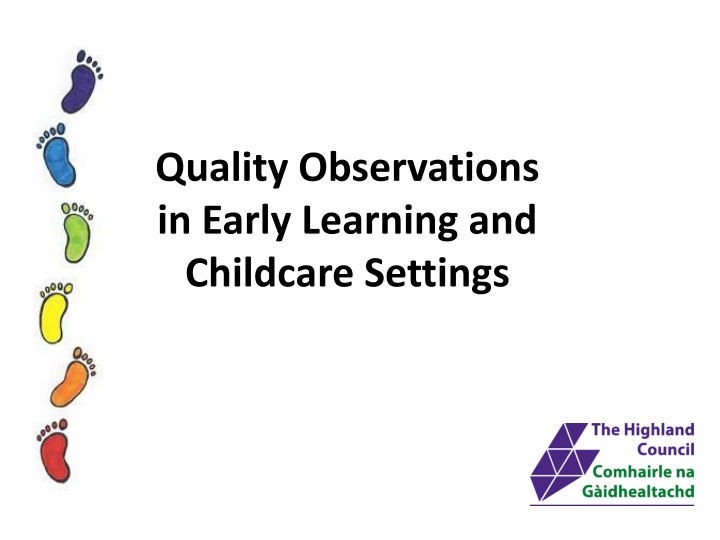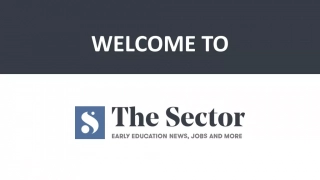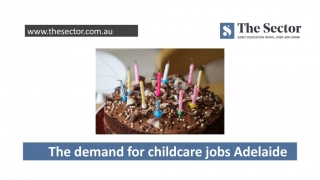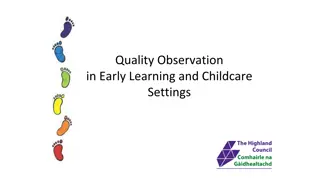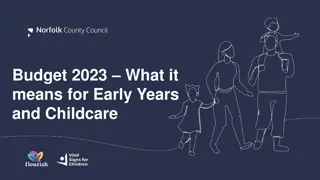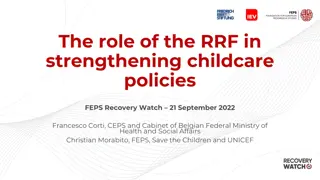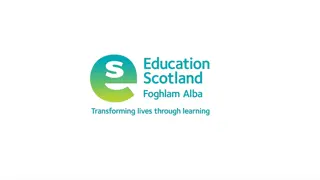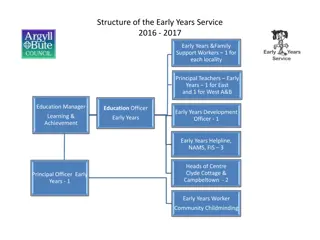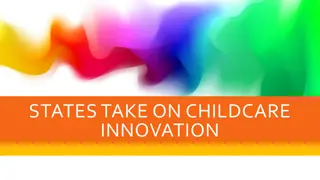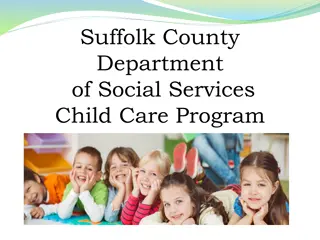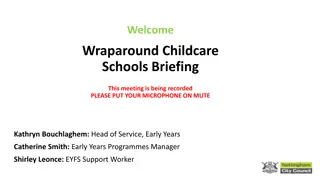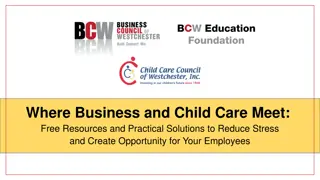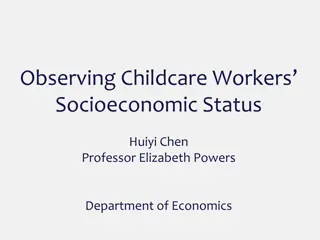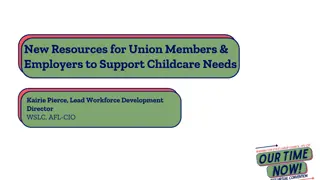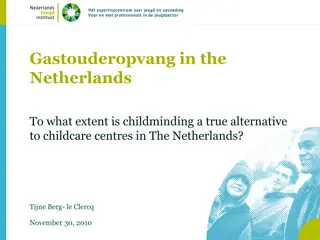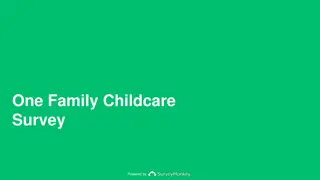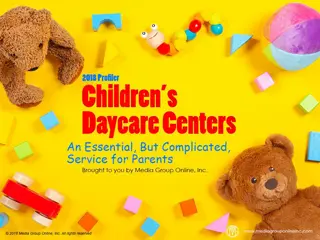Insights into Quality Observations in Early Learning and Childcare Settings
Explore the importance of quality observations in early learning and childcare settings to monitor children's progress and learning. Discover why, what, and how observations are made, along with the criteria for recording and evidencing progress. Learn about different types of observations and why practitioners observe children all the time. Gain insights from Highland Council's Key Learning Observations and understand the purpose of observing children.
Download Presentation

Please find below an Image/Link to download the presentation.
The content on the website is provided AS IS for your information and personal use only. It may not be sold, licensed, or shared on other websites without obtaining consent from the author.If you encounter any issues during the download, it is possible that the publisher has removed the file from their server.
You are allowed to download the files provided on this website for personal or commercial use, subject to the condition that they are used lawfully. All files are the property of their respective owners.
The content on the website is provided AS IS for your information and personal use only. It may not be sold, licensed, or shared on other websites without obtaining consent from the author.
E N D
Presentation Transcript
Quality Observations in Early Learning and Childcare Settings
Quality Observations in Early Learning and Childcare Settings
Quality Observations and Learning Conversations
Quality Observations in Early Learning and Childcare Settings Aims for the session: To explore why, what and how we observe children To revisit the criteria for recording observations To explore how children make progress and how we evidence it To explore different types of observations
Quality Observations in Early Learning and Childcare Settings Ultimately, observations are gathered so that practitioners can make informed judgements about how much children have learned and how well they are progressing in their learning. Education Scotland
Quality Observations in Early Learning and Childcare Settings In your current practice: When and how do you observe children?
Quality Observations in Early Learning and Childcare Settings When and how do you observe? All of the time! Our job is to observe the children from the minute they arrive to the minute they leave the setting. Observing children is not about setting up an activity for assessment.
Quality Observations in Early Learning and Childcare Settings Highland Council Guidance Key Learning Observations (KLO s) in Early Learning and Childcare
Observations in Early Learning and Childcare Settings Why do we observe?
Quality Observations in Early Learning and Childcare Settings Why do we observe? To find out about the child; their interests, what motivates them and their preferred way of learning or possible schema To build relationships of mutual trust and respect To gather information about each child s strengths, development and learning To ensure children s wellbeing and safety
Quality Observations in Early Learning and Childcare Settings Why do we observe? To monitor the child s progress and identify next steps for learning To use this to build up a holistic view of the child s learning, development and achievements To capture significant learning moments To support children in developing their awareness of their own learning
Quality Observations in Early Learning and Childcare Settings Why do we observe? Unless practitioners observe children with care and attentiveness, how can they possibly know what the child is interested in, what he can do, and what help he needs? Fisher 2016
Quality Observations in Early Learning and Childcare Settings What do we observe?
Quality Observations in Early Learning and Childcare Settings What do we observe? Significant, relevant learning and progress. What am I seeing/hearing that makes me sit up and take notice?
Quality Observations in Early Learning and Childcare Settings How do we observe?
Quality Observations in Early Learning and Childcare Settings How do we observe? Observation is about really listening to children and looking at what their play has to tell us Education Scotland
Quality Observations in Early Learning and Childcare Settings The Observation Cycle What did I see or hear? Notice What does this tell me? What does this mean? What will I do now? Observation Improve Analyse
Quality Observations in Early Learning and Childcare Settings Notice (What did I see or hear?) What does the child s actions, emotions and words tell you about their development and learning? Stepping back and noticing what the children are involved in is a skill that must be embedded into practice both in ELC and school settings. Realising the Ambition p 48 & 49
Quality Observations in Early Learning and Childcare Settings Observation can therefore be seen as noticing and trying to interpret what the child s actions, emotions and words mean in terms of what they are learning. We can observe what they are mastering and what they still need help, guidance and practice with. Our role includes noticing what the child does and how this might be changing over time. Realising the Ambition p 65
Quality Observations in Early Learning and Childcare Settings What is significant learning? Consider what you understand by significant learning . Identify an example of significant learning you have observed recently.
Quality Observations in Early Learning and Childcare Settings Identifying significant learning Watch the clips and identify what the significant learning might be. Consider possible next steps in learning.
Quality Observations in Early Learning and Childcare Settings Analyse (What does this tell me? What does this mean?) Is there engagement? Is there evidence of learning? Is there evidence of progress? Are you going to: Add an individual observation to a profile Inform planning Bin them!
Quality Observations in Early Learning and Childcare Settings It is the responsibility of all EYPs in a setting to recordchildren s learning through observations. Key workers are responsible for collating this information for their group of key children. The Role of the Key Worker (Highland Council)
Quality Observations in Early Learning and Childcare Settings Improve (What will I do now?) Effective observation practice should always result in action being taken Make a judgement about how much and how well a child has learned. Make a change to the learning environment to support and extend learning or to deepen an interest. Consider carefully interactions to support and extend learning. Education Scotland
Quality Observations in Early Learning and Childcare Settings Improve (What will I do now?) How do you show progression within Profiles ?
Quality Observations in Early Learning and Childcare Settings Criteria for Effective Written Observations Personalised Focus on learning and the skills being developed Note progression Specific Worded positively Dated
Quality Observations in Early Learning and Childcare Settings Activity To review where you are now Select one of your My Learning Journey s (a 4 year old s) Review the observations you have recorded in one or two of the core areas of Literacy, Numeracy, Health and Wellbeing
Quality Observations in Early Learning and Childcare Settings Ask yourself the following questions about the observations? Are they personalised? Are they focussed on learning and the skills being developed? Do they note progression? Are they specific? Are they worded positively?
Quality Observations in Early Learning and Childcare Settings Key Learning Observations (KLOs) KLOs are recorded across the eight curriculum areas. KLOs are up to date and dated. KLOs are personalised and worded positively. KLOs are specific and focus on learning and skills being developed. KLOs track progress within Literacy, Numeracy and Health and Wellbeing. KLOs are related to the learner s interests, anecdotal moments and developmental achievements. All photographs, learner s work and comments are accompanied by a written note about the learning. The learner s voice is included, e.g. quotes or comments on their learning.
Quality Observations in Early Learning and Childcare Settings Profiling and Reporting in Highland
Quality Observations in Early Learning and Childcare Settings Types of Observations Written Photographs Work Samples Time Samples
Quality Observations in Early Learning and Childcare Settings Photographs Should capture the child s learning Must always include a written note of the child s learning Can show progress in learning over time
Quality Observations in Early Learning and Childcare Settings Work Samples These can be drawings, paintings, writing, cutting etc. which demonstrate significant learning or skills Must always include a written note of the child s learning
Quality Observations in Early Learning and Childcare Settings Time Sample Can be used to track a child s actions or behaviour at regular intervals Can be used to observe an area of the setting at regular intervals
Quality Observations in Early Learning and Childcare Settings Self- Evaluation
Quality Observations in Early Learning and Childcare Settings Self-evaluation The three self-evaluative questions are a useful starting place: How are we doing? How do we know? What are we going to do now?
Quality Observations in Early Learning and Childcare Settings Resources to support observations can be found on the Early Learning and Childcare blog.
Quality Observations in Early Learning and Childcare Settings Further Reading to support professional development: Pre-birth to Three (2010) How good is our early learning and childcare? (2016) Realising the Ambition (2020) Interacting or Interfering? J. Fisher (2016) C. Nutbrown, Respectful Educators Capable Learner (1996) M. Drummond (1998) in S. Smidt, Observing Young Children (2010) The Children in Scotland publication: The Cycle of Observation, Assessment and Planning (2013) K. Brodie, Observation, Assessment and Planning in the Early Years (2015)
Quality Observations in Early Learning and Childcare Settings
Quality Observations in Early Learning and Childcare Settings Evaluation Please follow the link below to evaluate the online training resource. https://www.surveymonkey.co.uk/r/L2FB59S Thank you!
